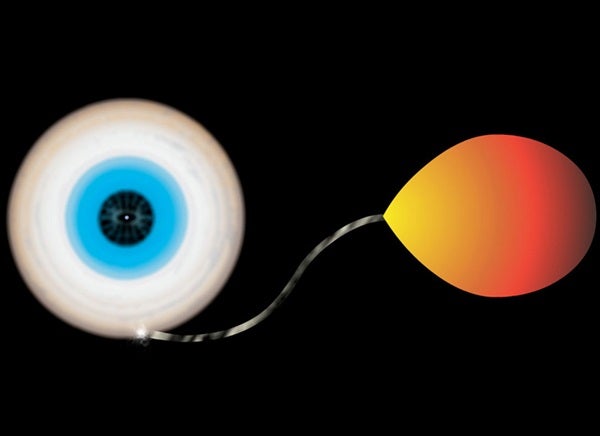Astronomers have discovered a unique double-star system that represents a “missing link” stage in what they believe is the birth process of the most rapidly spinning stars in the universe — millisecond pulsars.
“We’ve thought for some time that we knew how these pulsars get ‘spun up’ to rotate so swiftly,” said Anne Archibald of McGill University in Montreal, “and this system looks like it’s showing us the process in action.”
Pulsars are super-dense neutron stars, the remnants left after massive stars have exploded as supernovae. Their powerful magnetic fields generate lighthouse-like beams of light and radio waves that sweep around as the star rotates. Most rotate a few to tens of times a second, slowing down over thousands of years.
However, some millisecond pulsars rotate hundreds of times a second. Astronomers believe a companion star dumping material onto the neutron star and spinning it up causes the fast rotation. The material from the companion would form a flat, spinning disk around the neutron star, and, during this period, the radio waves characteristic of a pulsar would not be seen coming from the system. As the amount of matter falling onto the neutron star decreased and stopped, the radio waves could emerge, and the object would be recognized as a pulsar.
This sequence of events is apparently what happened with a binary-star system some 4,000 light-years from Earth. The millisecond pulsar in this system, called J1023, was discovered in 2007 by the National Science Foundation’s (NSF) Robert C. Byrd Green Bank Telescope (GBT) in West Virginia during a survey led by astronomers at West Virginia University and the National Radio Astronomy Observatory (NRAO).
The astronomers then found that the object had been detected by NSF’s Very Large Array (VLA) radio telescope during a large sky survey in 1998, and the Sloan Digital Sky Survey had observed it in visible light in 1999, revealing a Sun-like star.
When observed again in 2000, the object had changed dramatically, showing evidence for a rotating disk of material, called an accretion disk, surrounding the neutron star. By May 2002, the evidence for this disk had disappeared.
“This strange behavior puzzled astronomers, and there were several different theories for what the object could be,” said Ingrid Stairs of the University of British Columbia, who has been visiting the Australia Telescope National Facility and Swinburne University this year.
The 2007 GBT observations showed that the object is a millisecond pulsar, spinning 592 times per second.
“No other millisecond pulsar has ever shown evidence for an accretion disk,” Archibald said. “We know that another type of binary-star system, called a low-mass X-ray binary (LMXB), also contains a fast-spinning neutron star and an accretion disk, but these don’t emit radio waves. We’ve thought that LMXBs probably are in the process of getting spun up, and will later emit radio waves as a pulsar. This object appears to be the ‘missing link’ connecting the two types of systems.”
“It appears this thing has flipped from looking like an LMXB to looking like a pulsar, as it experienced an episode during which material pulled from the companion star formed an accretion disk around the neutron star,” said Scott Ransom of the National Radio Astronomy Observatory. “Later, that mass transfer stopped, the disk disappeared, and the pulsar emerged.”
The scientists have studied J1023 in detail with the GBT, with the Westerbork radio telescope in the Netherlands, with the Arecibo radio telescope in Puerto Rico, and with the Parkes radio telescope in Australia. Their results indicate that the neutron star’s companion has less than half the Sun’s mass, and orbits the neutron star once every 4.75 hours.
“This system gives us an unparalled ‘cosmic laboratory’ for studying how millisecond pulsars evolve,” Stairs said.
“Future observations of this system at radio and other wavelengths are sure to hold many surprises,” said Maura McLaughlin of West Virginia University.










